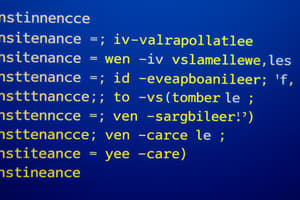Podcast
Questions and Answers
What is a class in the context of object-oriented programming?
What is a class in the context of object-oriented programming?
- A collection of objects
- A built-in data type
- A blueprint or template (correct)
- An instance of a blueprint
Where are the data members typically located in a UML class diagram?
Where are the data members typically located in a UML class diagram?
- In the private section of the class (correct)
- In the public section of the class
- In the constructor of the class
- In the destructor of the class
What is the purpose of a constructor in a class?
What is the purpose of a constructor in a class?
- To release memory reserved by the object
- To delete an object
- To initialize objects with data variables (correct)
- To display the properties of an object
What is the role of a destructor in C++?
What is the role of a destructor in C++?
What is the primary difference between a class and an object?
What is the primary difference between a class and an object?
What is true about memory management in C++?
What is true about memory management in C++?
What is the default access control for classes in C++?
What is the default access control for classes in C++?
What is the main feature of C++ that leads to Object-Oriented programming?
What is the main feature of C++ that leads to Object-Oriented programming?
What is a class in C++?
What is a class in C++?
What is an object in C++?
What is an object in C++?
What is the purpose of a class in C++?
What is the purpose of a class in C++?
What is the convention for naming classes in C++?
What is the convention for naming classes in C++?
What are the features of OOPS that revolve around classes in C++?
What are the features of OOPS that revolve around classes in C++?
Where can member functions of a class be defined?
Where can member functions of a class be defined?
What is the primary purpose of inheritance in object-oriented programming?
What is the primary purpose of inheritance in object-oriented programming?
What is polymorphism in object-oriented programming?
What is polymorphism in object-oriented programming?
What is the purpose of a UML class diagram?
What is the purpose of a UML class diagram?
What is the difference between a default constructor and an overloaded constructor?
What is the difference between a default constructor and an overloaded constructor?
What is the purpose of access specifiers in encapsulation?
What is the purpose of access specifiers in encapsulation?
What is method overriding in object-oriented programming?
What is method overriding in object-oriented programming?
How many sections does a UML class diagram have?
How many sections does a UML class diagram have?
What is the purpose of a setter function in a class?
What is the purpose of a setter function in a class?
Study Notes
Classes and Objects
- A class is a blueprint or template, with no storage assigned when defined.
- Objects are instances of a class, holding data variables and member functions working on those variables.
- Each object has different data variables and is initialized using special class functions called constructors.
- When an object is out of scope, a special class member function called a destructor is called to release memory.
Class Definition
- A class name should start with an uppercase letter, and the first letter of each word should be in uppercase if the name is more than one word.
- Classes contain data members and member functions, with access depending on access specifiers.
- Class member functions can be defined inside or outside the class definition.
Access Specifiers
- Public: can be accessed from anywhere
- Private: can be accessed only in the class where it is defined
- Protected: can be accessed in the class it was defined and any subclass of the class
Inheritance
- Inheritance allows a new class (derived class) to inherit properties and behaviors from an existing class (base class).
- It promotes reusability and establishes a relationship between the base class and the derived class.
Polymorphism
- Polymorphism means "many shapes" and allows objects of different classes to be treated as objects of a common superclass.
- Method Overloading: same method name, different parameters
- Method Overriding: same method name and parameters in the superclass and subclass, with the subclass overriding the superclass method.
UML Class Diagram
- A visual representation of the structure and relationships among classes in an object-oriented system.
- Provides a high-level overview of classes, their attributes, methods, and associations.
- The UML Class Diagram has three sections: public, private, and protected.
Studying That Suits You
Use AI to generate personalized quizzes and flashcards to suit your learning preferences.
Description
This quiz covers the fundamentals of object-oriented programming, including classes, objects, and their attributes and operations.




